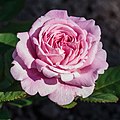
Monza is a city and comune on the River Lambro, a tributary of the Po in the Lombardy region of Italy, about 20 kilometres north-northeast of Milan. It is the capital of the Province of Monza and Brianza. Monza is best known for its Grand Prix motor racing circuit, the Autodromo Nazionale di Monza, which hosts the Formula One Italian Grand Prix with a massive Italian support tifosi for the Ferrari team.
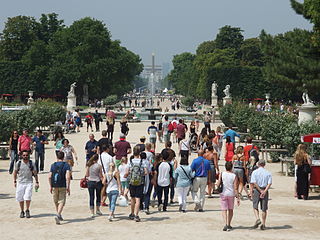
The Tuileries Garden is a public garden between the Louvre and the Place de la Concorde in the 1st arrondissement of Paris, France. Created by Catherine de' Medici as the garden of the Tuileries Palace in 1564, it was opened to the public in 1667 and became a public park after the French Revolution. Since the 19th century, it has been a place for Parisians to celebrate, meet, stroll and relax.

The early history of gardening is largely entangled with the history of agriculture, with gardens that were mainly ornamental generally the preserve of the elite until quite recent times. Smaller gardens generally had being a kitchen garden as their first priority, as is still often the case.

Water garden or aquatic garden, is a term sometimes used for gardens, or parts of gardens, where any type of water feature is a principal or dominant element. The primary focus is on plants, but they will sometimes also house waterfowl, or ornamental fish, in which case it may be called a fish pond. They vary enormously in size and style.

Villa Borghese is a landscape garden in Rome, containing a number of buildings, museums and attractions. It is the third-largest public park in Rome, after the ones of the Villa Doria Pamphili and Villa Ada. The gardens were developed for the Villa Borghese Pinciana, built by the architect Flaminio Ponzio, developing sketches by Scipione Borghese, who used it as a villa suburbana, or party villa, at the edge of Rome, and to house his art collection. The gardens as they are now were remade in the late 19th century.

The Buen Retiro Park, Retiro Park or simply El Retiro is one of the largest parks of the city of Madrid, Spain. The park belonged to the Spanish monarchy until 1868, when it became a public park.

New England Botanic Garden at Tower Hill is a 171-acre botanic garden and arboretum located in Boylston, Massachusetts, approximately 8 miles (13 km) north of central Worcester in Worcester County, Massachusetts. The Garden features 18 distinct gardens, preserved woodlands, and miles of walking trails.

The Château de Bagatelle in Paris is a small Neoclassical-style château with several French formal gardens, a rose garden and an orangerie. It is set on 59 acres of grounds in French landscape style within the Bois de Boulogne, which is located in the 16th arrondissement of Paris.

Hamilton Gardens is a public garden park in the south of Hamilton owned and managed by Hamilton City Council in New Zealand. The 54-hectare park is based on the banks of the Waikato River and includes enclosed gardens, open lawns, a lake, a nursery, a convention centre and the Hamilton East Cemetery. It is the Waikato region's most popular visitor attraction, attracting more than 1 million people and hosting more than 2,000 events a year.

The University of Guelph Arboretum was formally established in 1970 by the University of Guelph. The Arboretum aims to conserve biodiversity and connect people with nature through teaching, research, and community outreach. The 165 hectare space serves as an “outdoor learning resource,” a “living laboratory” and a “community resource”. The Arboretum is open all year round to the public from dawn to dusk, and admission is free. It is used for a wide array of purposes such as teaching, research, conservation, recreation, school programs, adult workshops, and walking tours. It is also a popular place for weddings and ceremonies. There are more than 40 collections of woody plants for academic and display purposes, as well as various display gardens, memorial plantings, and facilities.

The Musée de l'Orangerie is an art gallery of impressionist and post-impressionist paintings located in the west corner of the Tuileries Garden next to the Place de la Concorde in Paris. The museum is most famous as the permanent home of eight large Water Lilies murals by Claude Monet, and also contains works by Paul Cézanne, Henri Matisse, Amedeo Modigliani, Pablo Picasso, Pierre-Auguste Renoir, Henri Rousseau, Alfred Sisley, Chaïm Soutine, Maurice Utrillo, and others.

The Giardini Botanici Villa Taranto are botanical gardens located on the western shore of Lake Maggiore in Pallanza, Province of Verbano-Cusio-Ossola, Italy. They are open daily; an admission fee is charged.

A rose garden or rosarium is a garden or park, often open to the public, used to present and grow various types of garden roses, and sometimes rose species. Designs vary tremendously and roses may be displayed alongside other plants or grouped by individual variety, colour or class in rose beds. Technically it is a specialized type of shrub garden, but normally treated as a type of flower garden, if only because its origins in Europe go back to at least the Middle Ages in Europe, when roses were effectively the largest and most popular flowers, already existing in numerous garden cultivars.
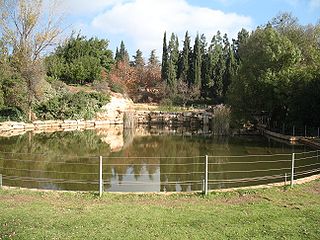
Wohl Rose Park is a public garden in Givat Ram, Jerusalem, located opposite the Knesset and government precinct, at the foot of the Israeli Supreme Court.

The Europa-Rosarium, formerly the Rosarium Sangerhausen, is a municipal rose garden located in Sangerhausen, Saxony-Anhalt, Germany. With 8300 cultivars and species it is one of the largest rose collection in the world, playing an important role as budwood source and in research. In 2003 it was granted the Award of Garden Excellence by the World Federation of Rose Societies.
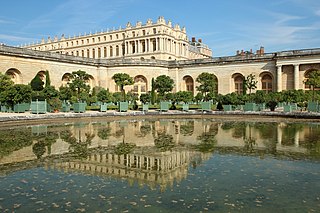
The Versailles Orangerie was built by Jules Hardouin-Mansart between 1684 and 1686, before work on the Château de Versailles had even begun. The Orangerie, which replaced Louis Le Vau's earlier design from 1663, is an example of many such prestigious extensions of grand gardens in Europe designed both to shelter tender plants and impress visitors. With the addition of the Orangerie, the gardens, no longer reserved solely for use by Louis XIV, had the added use of a theatrical setting that could be used to entertain guests at court.

The Royal Villa is a historical building in Monza, Northern Italy. It lies on the banks of the Lambro river, surrounded by the large Monza Park, one of the largest enclosed parks in Europe.

Italian garden typically refers to a style of gardens, wherever located, reflecting a number of large Italian Renaissance gardens which have survived in something like their original form. In the history of gardening, during the Renaissance, Italy had the most advanced and admired gardens in Europe, which greatly influenced other countries, especially the French formal garden and Dutch gardens and, mostly through these, gardens in Britain.
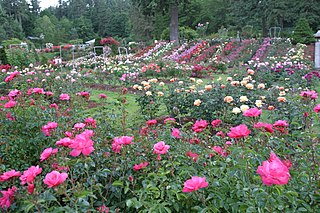
Rose trial grounds or rose test gardens are agricultural areas where garden roses are grown to be assessed for qualities such as health, floriferousness, novelty, and scent.




















